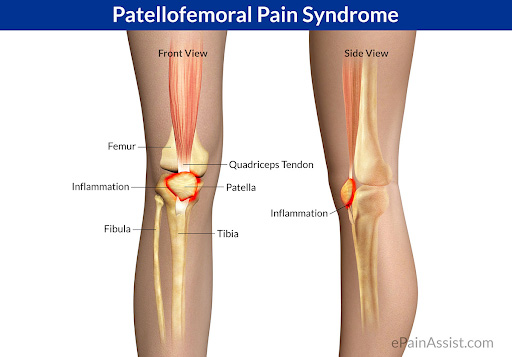Patellofemoral Pain Syndrome
Patellofemoral Pain Syndrome (PFPS) is a common condition that causes pain in the front of the knee, under or around the kneecap (patella). It accounts for 20-25% of all reported knee pain. Furthermore, it occurs in all age ranges, females more often than males. Patellofemoral Pain Syndrome largely affects those who play sports. Understanding this condition will assist in the recovery process.

What is Patellofemoral Pain Syndrome?
PFPS is a broad term used to describe pain in the front of the knee and around the patella, or kneecap. Many refer to it as “runner’s knee” or “jumper’s knee” because it is common in sports. Studies suggest that PFPS results from doing too much too soon. This doesn’t allow the body to recover and results in inflammation, and pain. PFPS rarely gets better on its own. If you have these symptoms it is important to seek care from a Physical Therapist.

Symptoms of Patellofemoral Pain Syndrome
- Pain in the front or around the kneecap
- Symptoms worsen with activity
- Walking up or downstairs
- Playing a sport
- Deep knee bending (squatting)
- Walking on even surfaces
- Sitting for a long time
How is Patellofemoral Pain Syndrome Diagnosed?
Your physical therapist will perform a few tests to determine if PFPS is present. First, they will take a comprehensive health history. Then they will perform a physical examination. During the physical examination your therapist will perform the following:
- Analyze the movements that are causing the pain
- Analyze your walking and running patterns
- Test the strength of your hip and thigh muscles
- Rule out other conditions, such as meniscus injuries
What are the risk factors for Patellofemoral Pain Syndrome?
- Weakness of the thigh and hip muscles
- Repetitive movements such as specializing in a single sport
- Inefficient movement patterns
How can I prevent Patellofemoral Pain Syndrome?
There are a few things you can do to help prevent PFPS. The goal is to reduce stress on the kneecap. Appropriate footwear and custom orthotics can help. Modifying activities to limit those that exacerbate the condition. A strength and flexibility program to maximize knee mechanics can also help. Discuss these strategies further with your physical therapist.
What will my PT have me do to recover from Patellofemoral Pain Syndrome?
The approach to treatment will be individual for each patient. There several key areas will need to be included:
Strengthening and endurance exercises: these exercises will target muscle of the knee and hip that are weak. Examples are squats, lunges, and lateral band walks. Click here to see our hip strengthening series on youtube.

Coordination training. Based on the assessment of your movement patterns, corrections may need to be made. This will retrain the muscle to move more efficiently.
This type of training is effective for athletes, in particular, and may focus on movements like:
- Stair climbing
- Squatting
- Running and jumping
Mobility exercises: These exercises will help restore any motion that has been lost. Exercises may target hamstrings, hip flexors, and calf muscles.
Cross-training guidance. Education will be given to help the patient perform different movements to help limit deconditioning. This also helps to stay active until they can return to a favorite activity.
Return to full activity. Your physical therapist will help guide a gradual return to your favorite activities, such as running, jumping, and recreational activities.
If the injury is not getting better or you have any concerns, schedule an appointment with a Physical Therapist. At Symmetry Physical Therapy, our therapists are specially trained in a variety of areas to get you back to living the life you want as soon as possible! Our Physical Therapists will review your medical history and complete a thorough examination of your knee and hip. Then they will assess your posture, strength, flexibility, and movement. All to determine the source of the problem and come up with a plan to recover and meet your goals.
How Long Will It Take to Recover From Patellofemoral Pain Syndrome?
PFPS can take anywhere from 2 weeks to 6 months. Once you begin therapy you will start to feel better. The time frame for recovery depends on the extent and cause of the condition. Rehabilitation is important to restore knee strength and flexibility as well as to prevent a recurrence. Seeing a Physical Therapist, who creates a plan tailored to your individual needs can be helpful in decreasing the recovery time and preventing a re-injury. So, if you have any questions or are looking to recover as soon as possible click here to schedule an appointment to see us today!
